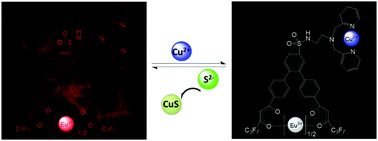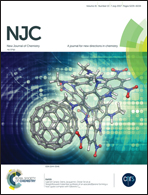A β-diketonate–europium(iii) complex-based fluorescent probe for highly sensitive time-gated luminescence detection of copper and sulfide ions in living cells†
Abstract
We have developed a novel β-diketonate–europium(III) complex-based fluorescent probe, Eu3+-BHHCT-BPED, by introducing Cu2+-binding dipicolylamine (DPA)-containing N,N-bis(2-pyridylmethyl)ethanediamine (BPED) into a tetradentate β-diketone ligand 4,4′-bis(1′′,1′′,1′′,2′′,2′′,3′′,3′′-heptafluoro-4′′,6′′-hexanedione-6′′-yl)chlorosulfo-o-terphenyl (BHHCT). The probe was strongly fluorescent with a high quantum yield (57.6%) and a long luminescence lifetime (0.81 ms). Upon addition of Cu2+ ions, the fluorescence emission of Eu3+-BHHCT-BPED at 607 nm was selectively and efficiently quenched due to the coordination of Cu2+ ions with the BPED moiety. Furthermore, the resulting heterobimetallic complex Eu3+-BHHCT-BPED-Cu2+ displayed specific luminescence response to sulfide ions because a reversible fluorescence revival was induced by the formation of CuS. The “on–off–on” type signaling behavior of Eu3+-BHHCT-BPED towards Cu2+ and sulfide ions enabled the sensing of the two species with the detection limits of 3.7 nM and 0.19 μM, respectively. The time-gated luminescence imaging study has demonstrated the applicability of Eu3+-BHHCT-BPED for monitoring intracellular Cu2+ and sulfide ions with high sensitivity and selectivity.



 Please wait while we load your content...
Please wait while we load your content...